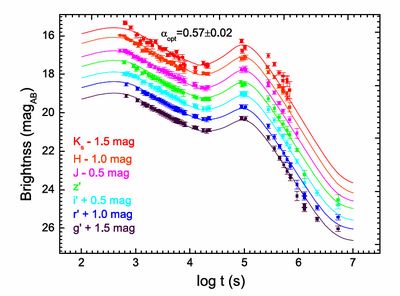In recent years, more and more gamma-ray bursts (GRBs) with late rebrightenings in their multi-band afterglows have revealed the late-time activity of their central engines. GRB 100814A is a special case among the well-sampled events, with complex temporal and spectral evolution. The single power-law shallow decay index of the optical light curve observed by GROND between 640 s and 10 ks is alpha(opt) = 0.57 +/- 0.02, which apparently conflicts with expectations from the simple external shock model. In particular, there is remarkable rebrightening in the optical to near-infrared bands at late times, challenging the external shock model with synchrotron emission coming from the interaction of the blast wave with the surrounding interstellar medium. In this paper, we invoke a magnetar with spin evolution to explain the complex multi-band afterglow emission of GRB 100814A. The initial shallow decay phase in the optical bands and the plateau in the X-ray can be explained as being due to energy injection from a spin-down magnetar. At late times, with materials from the fall-back disk falling onto the central object of the burster, the angular momentum of the accreted materials is transferred to the magnetar, which leads to a spin up process. As a result, the magnetic dipole radiation luminosity will increase, resulting in significant rebrightening of the optical afterglow. We show that the model can well reproduce the observed multi-band afterglow emission. 
Figure 2. Numerical fit to the observed GROND seven band optical afterglow light curves of GRB 100814A using the same model parameters as in Figure 1.The points represent the observational data from Nardini et al. (2014). The solid lines correspond to our theoretical optical afterglow light curves with extinction corrected. A 0.5 mag shift between two adjacent light curves is applied in the plot for clarity. The research work by Y. B. Yu, Y. F. Huang , X. F. Wu , etc. has been published in The Astrophysical Journal, 805:88 (6pp), 2015 June 1, For more details, please see the following link: http://apps.webofknowledge.com/full_record.do?product=UA&search_mode=GeneralSearch&qid=1&SID=Z2PKooMeXasGywdW2F3&page=1&doc=5 (Information Source: Purple Mountain Observatory, CAS) |

